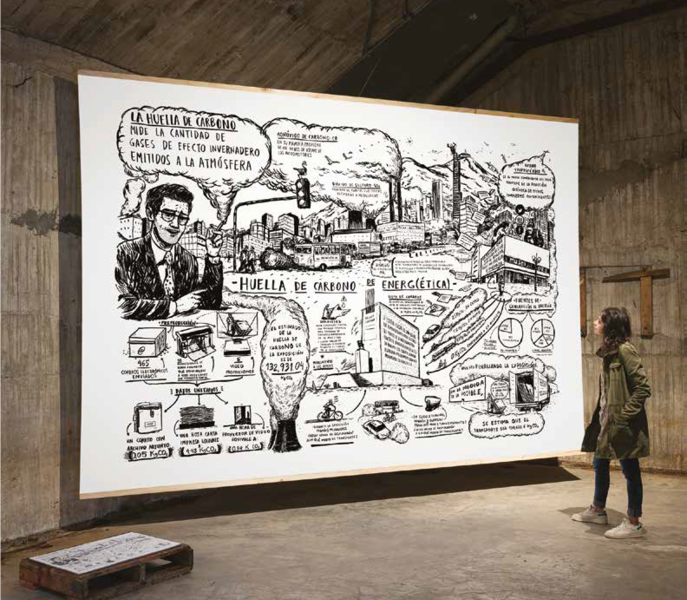ENERG(ETHICS)
Surrounded by great avenues, in the middle of an unbearable traffic, deafening noise and air difficult to breathe, the Monument of the Heroes is found. A tower of rectangular stone inaugurated in 1963 in homage to the memory of the soldiers who participated in the independence of the Bolivarian countries. Clearly, it is one of the most characteristic landmarks of the Colombian capital. However, only a handful of brave rebels in skates and skateboards dwelled during the last 50 years in this no man’s land guarded by the equestrian statue of Simón Bolivar. The first great success of the exhibition Energ(ética)[Energ(ethic)], curated by Jose Roca (Artistic Director, FLORA ars+nature) and Isaac Dyner (Dean of Natural Sciences and Engineering at the Jorge Tadeo Lozano University) is that for a few weeks it radically revitalizes this inhospitable place with an exhibition that questions the uses of natural resources in an accelerated economic system of consumption.

Almost 30 artists participate: Adrián Balseca, Alberto Baraya, Andreas Siekmann, Camilo Bojacá, Carolina Caycedo, Clemencia Echeverri, Eduardo Navarro, Elisa Balmaceda and Cristian Espinoza, Ernesto Benavides, Fernanda Viégas & Martin Wattenberg, Joaquín Fargas, Julián Henao, Harold Fisk, Lina Mazenett and David Quiroga, Marcela Magno, María Elvira Escallón, Mauro Vallejo, Michelle-Marie Letelier, Miler Lagos, Nicholas Mangan, Nomeda and Gediminas Urbonas, Olafur Eliasson, Pilar Santamaría, Rodrigo Toro, Santiago Leal, Sebastián Restrepo, Tangrama & Altiplano, Tania Candiani, Tomás Munita, Tomás Saraceno. Unprepared passers-by and curious visitors walk with amazement the unknown entrails of this building-monument, located in one of the most polluted places in Bogota.
The curators shared a lot of information associated with the exhibition and the energetic resources that were used in its production
The inside of The Heroes is surprisingly spacious, dark but pleasant, full of nooks and crannies, stairs that go up and down. From the same moment the eye begins to get used tothe change of light, works of art with different formats appeareverywhere: videos, some photographs, sound installations and strange machines. The exhibition develops as an extraordinary sensory experience. The mysterious darkness and the ruined walls of the building, complement very well with the noises that emerge from some of the works and the lights of the screens and pieces of light. Travelling through this space is a real adventure. The first piece you see on entering is alarge black ink print on a white synthetic surface. It is a kind of poster, difficult to understand at first, but slowly revealing itself as a space where curators shared a lot of information associated with the exhibition and the resources that were used in its production. A whole statement of intentions that accounts for the honest spirit of the sample by directly questioning its own meaning with some surprising data suchas the estimate of the carbon footprint of same Energ(ethic), that reaches a total of 132,931.04 KgCo2. This infographic also details the resources used in sending emails and other documentation, the energy expenditure of transporting materials and works, displacement of workers, spending of the screens and electronic devices for the exhibition, paper used in the production, etc. It is one of the most interesting and less rhetorical “curatorial texts” I have seen in years.
-
"Planta de energía de la Piedra de Folk", 2017, Nomeda & Gediminas Urbonas. Digital impression. Exhibition copy. / Impresión digital. Copia de exhibición.
Pilar Santamaría. Re-conectando Flujos Vitales, 2012-2017. Installation. Property of the artist. / Instalación. Propiedad de la artista. -
"Piedra de Sol", 2017, Lina Mazenett & David Quiroga Coal, slide projector, light box powered by solar panel. Property of the artists. Carbón mineral, proyectos de diapositivas, caja de luz alimentada por panel solar. Propiedad de los artistas.
-
Serie/ Series "Nuevas floras del sur", 2017, María Elvira Escallón. Property of the artist. / Propiedad de la artista. Nicholas Mangan. Progress in Action, 2013 Instalación y video monocanal 4’18”. Planta eléctrica de diesel, aceite de coco refinado y proyección sobre pantalla en lona militar. Exhibition copy. Installation and mono channel video 4’18 “. Diesel electric plant, refined coconut oil and projection on military canvas screen. Copia de exhibición.
The works included are of diverse nature; they speak directly and indirectly of key issues related to the current environmental problems. They approach the subject analyzing the political and social implications of the use of resources, the forms of production in a capitalist system of consumption, the relationships between large exploitation companies and governments, the notion of sustainability, and legal and illegal use of fossil energy and mining.
Art has a lot to say and propose about the current situation of the planet and Energ(ethics) gives voice to artists. Do not wait for the heroes, the task belongs to everyone!
All this is developed without a moralistic or environmentally “evangelizing” intention. It is a meeting of critical perspectives that generate questions and empower solutions, beyond being simple complaints or failed militancy. The work of many contemporary artists is no stranger to the concerns that documentarists, scientists, politicians and economists have been publishing for decades. Art has a lot to say and propose about the current situation of the planet and Energ(ethics) gives voice to artists. Do not wait for the heroes, the task belongs to everyone!




